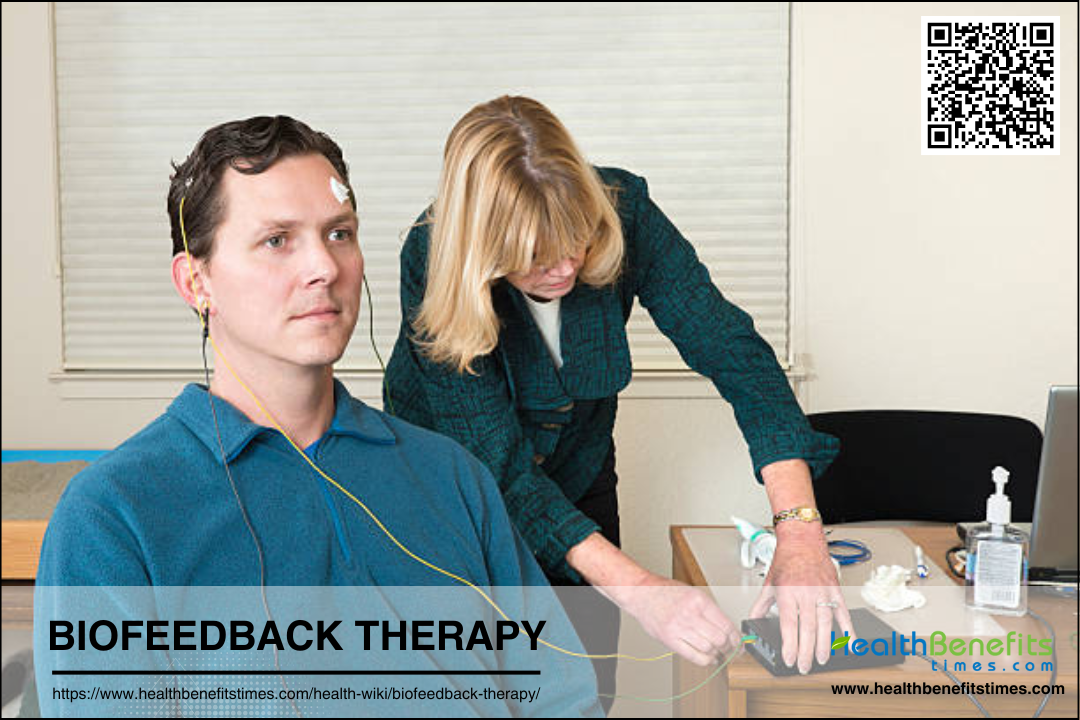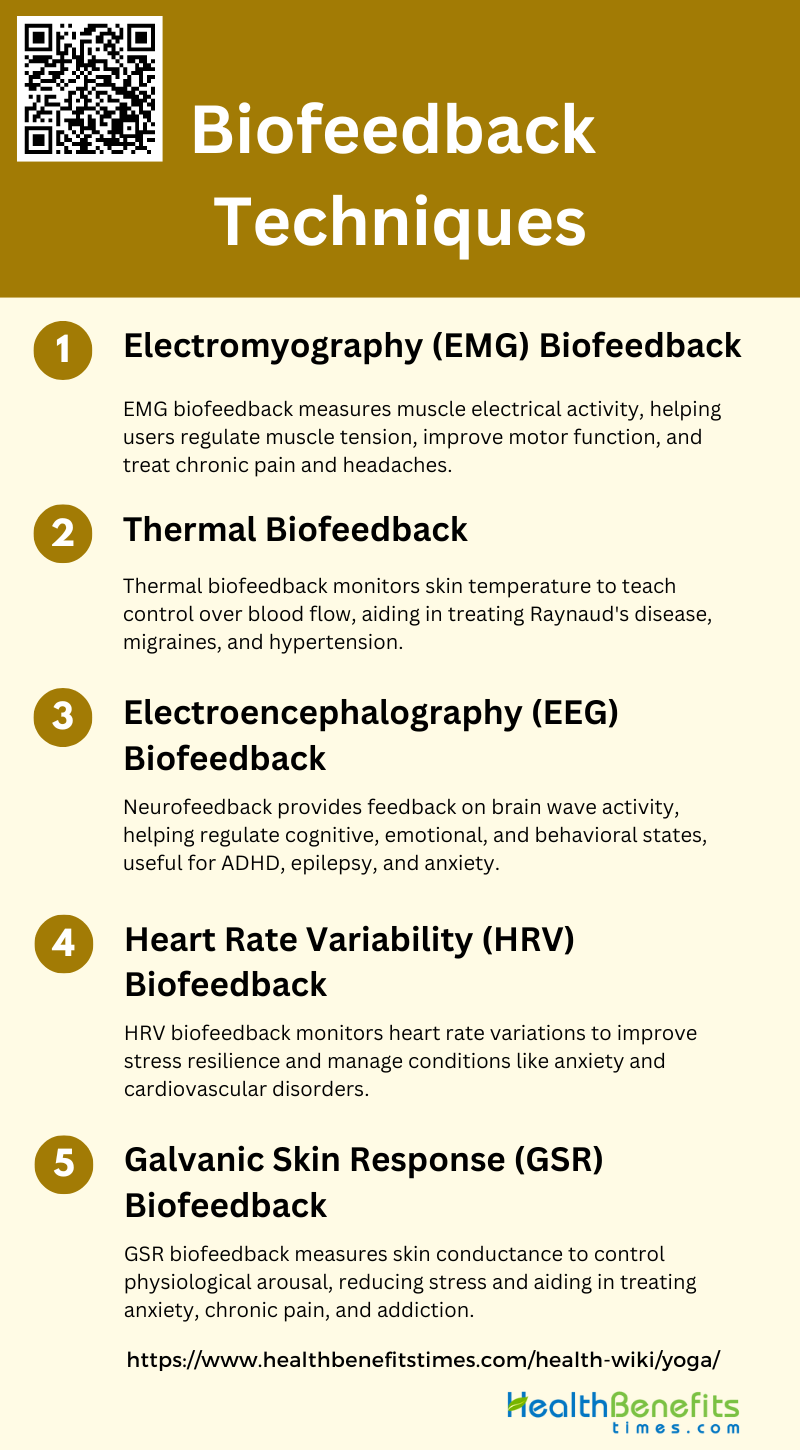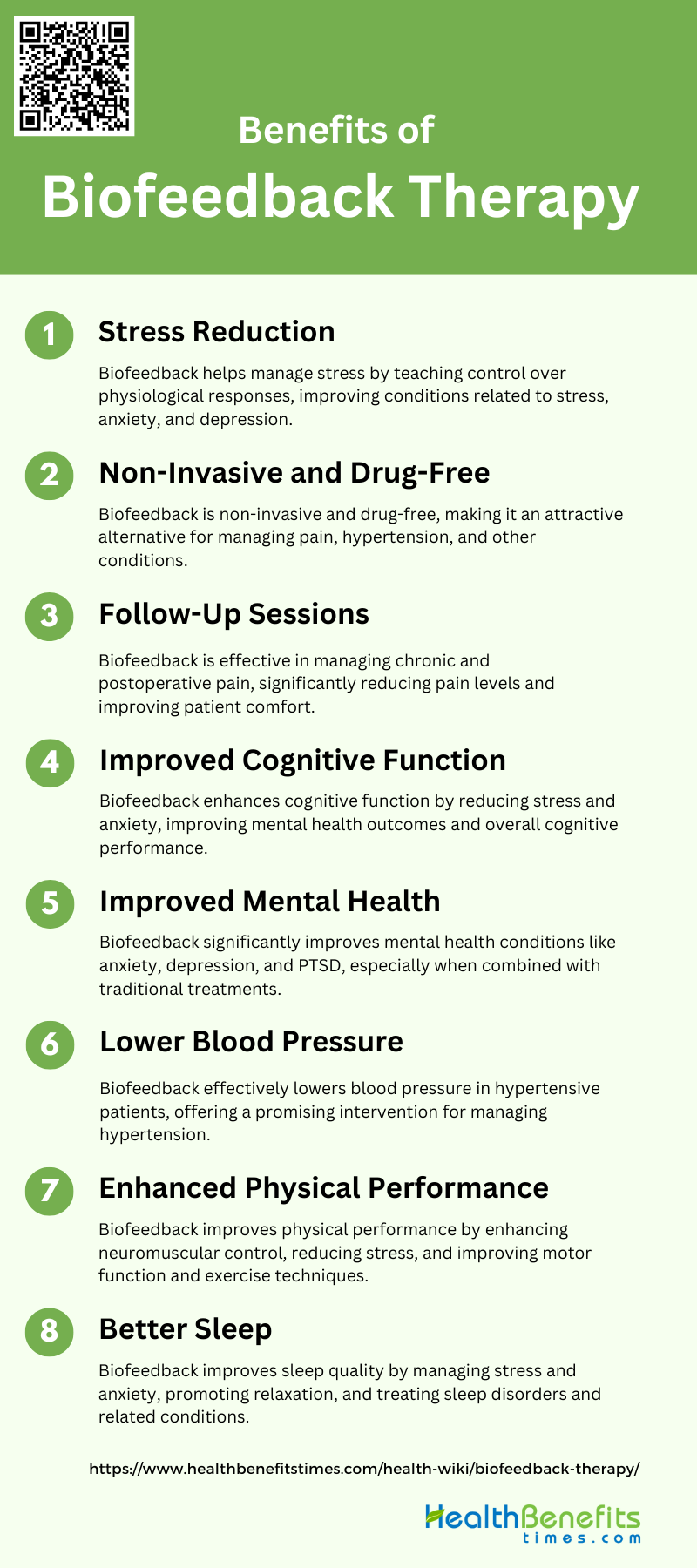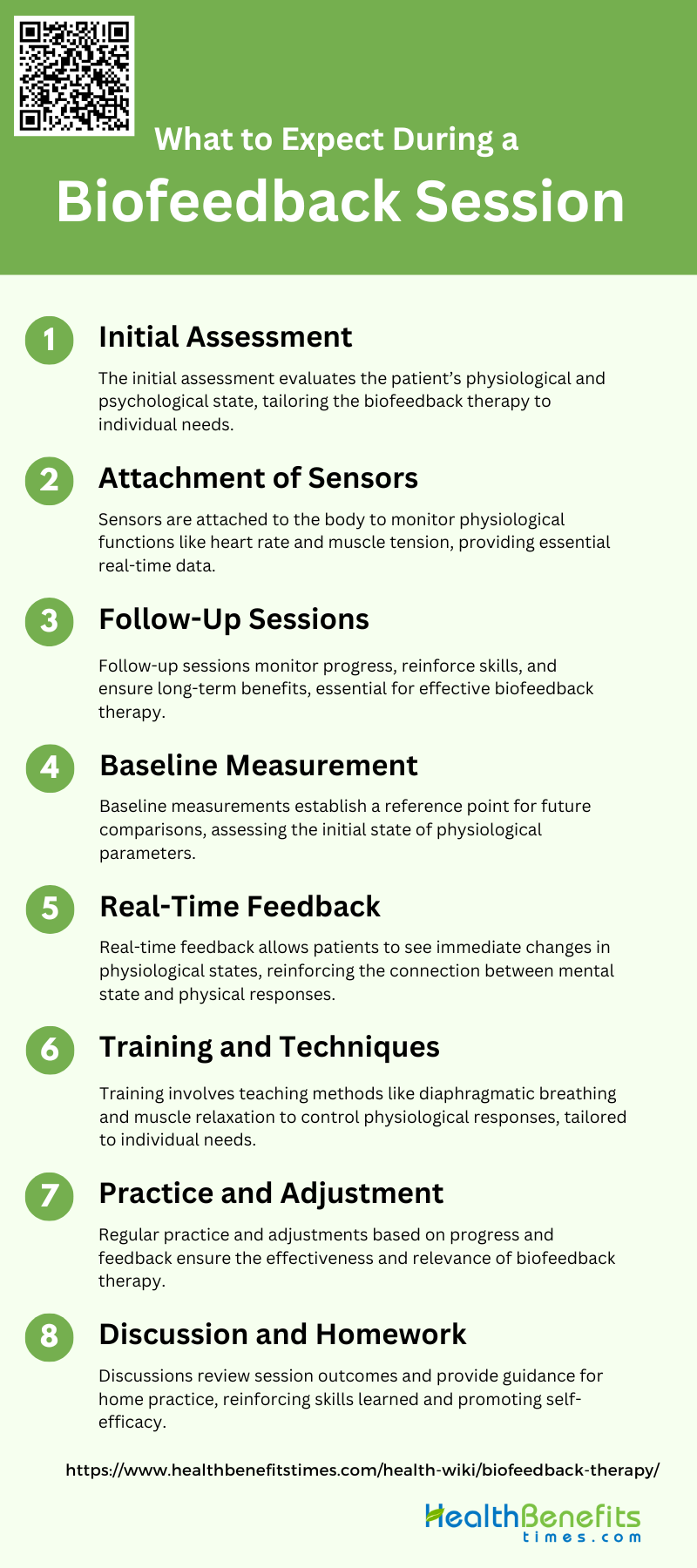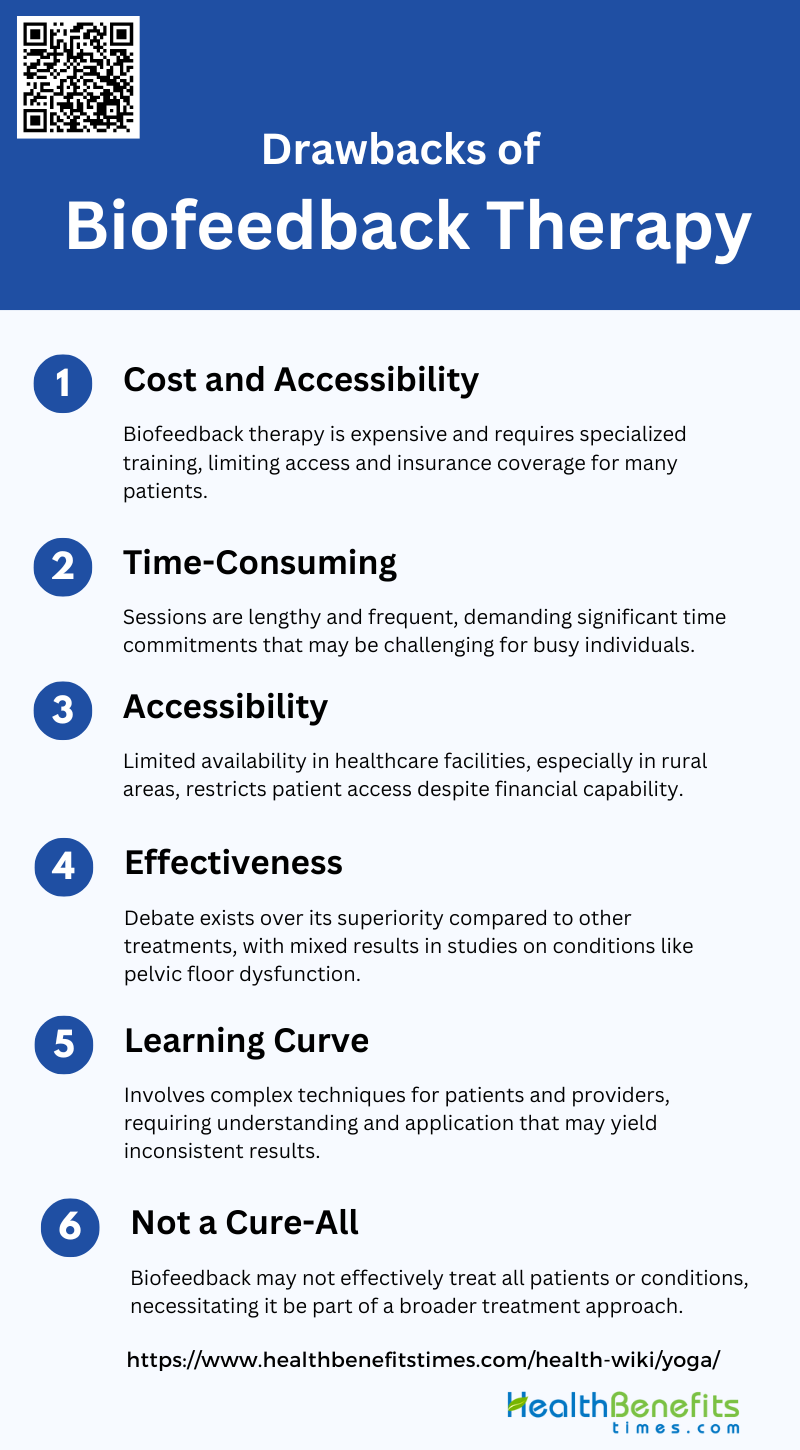Biofeedback therapy is a non-invasive treatment method that helps individuals gain control over physiological functions by using real-time feedback from monitoring devices. It involves training patients to improve their health by using signals from their own bodies. This therapy is used to manage a variety of conditions, including chronic pain, cardiovascular diseases, and defecation disorders, by teaching patients to regulate bodily processes such as heart rate, muscle tension, and blood pressure. Techniques often involve the use of sensors to measure physiological activity, which is then displayed to the patient through visual or auditory feedback, enabling them to learn how to control these functions. Biofeedback has shown promise in improving symptoms and quality of life in various clinical populations, although more systematic research is needed to fully establish its efficacy and standardize its application.
How Does Biofeedback Therapy Work?
This feedback is typically delivered through visual, auditory, or haptic signals. For instance, electromyography (EMG) biofeedback, which measures muscle activity, has been shown to be effective in treating musculoskeletal conditions and improving motor function in post-stroke rehabilitation. Similarly, cardiovascular biofeedback can help manage conditions like hypertension and heart failure by teaching patients to control their heart rate and blood pressure. Biofeedback has also been found effective in reducing the frequency and severity of tension-type headaches and migraines. In the context of rehabilitation, biofeedback can enhance the effects of physical therapy by improving balance and mobility in stroke patients. Overall, biofeedback therapy leverages the body’s physiological data to empower patients to make conscious adjustments, thereby improving their health outcomes.
Types of Biofeedback Therapy
These therapies are used to manage a range of health conditions by providing real-time feedback on bodily processes. By learning to control these functions, patients can improve their physical and mental well-being. Here are some common types of biofeedback therapy:
- Electromyography (EMG)
- Thermal biofeedback
- Neurofeedback (Electroencephalography or EEG)
- Heart rate variability (HRV)
- Galvanic skin response (GSR)
- Electrodermal Activity (EDA) Biofeedback
- Pneumography
- Capnometry
- Hemoencephalography
- Photoplethysmography (PPG)
Biofeedback Devices
Biofeedback devices are tools used to help individuals gain control over physiological functions by providing real-time feedback. These devices measure various bodily functions such as heart rate, muscle tension, skin temperature, and brain wave activity. The feedback is typically displayed through visual or auditory signals, allowing users to learn how to regulate these functions consciously.
1. Electromyography (EMG)
Electromyography (EMG) biofeedback is a technique that measures muscle electrical activity to help individuals gain control over muscle tension. It has been extensively studied for its efficacy in treating tension-type headaches (TTH) and stress-related conditions. EMG biofeedback can be delivered through various modes, including auditory, visual, and combined audio-visual feedback. Studies have shown that EMG biofeedback is effective in reducing headache frequency, duration, and intensity, as well as improving the quality of life for TTH patients. Additionally, EMG biofeedback has been compared with other biofeedback methods, such as galvanic skin response (GSR), to determine its relative effectiveness in stress management.
2. Thermal Biofeedback
Thermal biofeedback involves monitoring skin temperature to help individuals learn to control their physiological responses to stress. This method is based on the principle that skin temperature decreases under stress due to vasoconstriction and increases when the individual is relaxed. Thermal biofeedback has been used to treat various conditions, including anxiety disorders and hypertension. By training individuals to increase their skin temperature, thermal biofeedback can help reduce stress and improve autonomic function. Although not explicitly covered in the provided papers, thermal biofeedback shares similarities with other biofeedback methods in its non-invasive approach and potential for improving mental and physical health outcomes.
3. Electroencephalography (EEG)
Electroencephalography (EEG) biofeedback, also known as neurofeedback, involves training individuals to modulate their brainwave activity. This method has been explored for its potential in treating epilepsy, anxiety disorders, and other neurological conditions. EEG biofeedback can target specific brainwave frequencies, such as sensory motor rhythm (SMR) and slow cortical potentials (SCP), to achieve therapeutic effects. Studies have shown that EEG biofeedback can help individuals gain volitional control over their brain activity, leading to improved outcomes in epilepsy management and anxiety reduction. The efficacy and neural mechanisms of EEG biofeedback are relatively well-characterized, making it a promising intervention for various mental health conditions.
4. Heart Rate Variability (HRV)
Heart rate variability (HRV) biofeedback is a technique that trains individuals to control their heart rate variability, which is an indicator of autonomic nervous system function. HRV biofeedback has been shown to improve autonomic function, baroreflex sensitivity, and reduce blood pressure in individuals with prehypertension. By enhancing vagal tone and reducing sympathetic activity, HRV biofeedback can facilitate cardiovascular health and stress management. Studies have demonstrated that HRV biofeedback is effective in reducing blood pressure and improving overall autonomic balance, making it a valuable tool for individuals at risk of hypertension and cardiovascular diseases.
5. Galvanic Skin Response (GSR)
Galvanic skin response (GSR) biofeedback measures electrodermal activity, which reflects changes in skin conductance due to sympathetic nervous system activity. GSR biofeedback has been explored for its potential in treating epilepsy, tension-type headaches, and mental disorders. By training individuals to control their electrodermal activity, GSR biofeedback can help manage psychophysiological arousal and improve emotional regulation. Studies have shown that GSR biofeedback is effective in reducing seizure frequency in drug-resistant epilepsy patients and improving the quality of life for individuals with tension-type headaches. Additionally, GSR biofeedback has been used in neurorehabilitation for mental disorders, highlighting its potential as a non-invasive therapeutic approach.
Biofeedback Techniques
Biofeedback techniques involve using biofeedback devices to monitor physiological functions and provide real-time feedback to help individuals learn to control these functions. Here are some common biofeedback techniques:
1. Electromyography (EMG) Biofeedback
Electromyography (EMG) biofeedback is a technique that measures the electrical activity of muscles and provides feedback to the user, allowing them to learn how to control and regulate muscle tension. It is commonly used in physical rehabilitation, such as for stroke patients, to improve muscle strength, coordination, and motor function. EMG biofeedback can also be applied to treat conditions like chronic pain, headaches, and temporomandibular disorders by teaching individuals to reduce excessive muscle tension.
2. Thermal Biofeedback
Thermal biofeedback involves monitoring and providing feedback on skin temperature, typically at the fingertips or hands. It is based on the principle that changes in skin temperature reflect changes in blood flow, which is influenced by the autonomic nervous system. This technique has been used to treat conditions like Raynaud’s disease, migraine headaches, and hypertension by teaching individuals to increase peripheral blood flow and promote relaxation.
3. Electroencephalography (EEG) Biofeedback (Neurofeedback)
Neurofeedback, also known as EEG biofeedback, involves measuring and providing feedback on brain wave activity. It is used to help individuals learn to regulate specific brain wave patterns associated with various cognitive, emotional, and behavioral states. Neurofeedback has been explored as a potential treatment for conditions like attention deficit hyperactivity disorder (ADHD), epilepsy, anxiety, and depression.
4. Heart Rate Variability (HRV) Biofeedback
Heart rate variability (HRV) biofeedback involves monitoring and providing feedback on the beat-to-beat variations in heart rate, which are influenced by the autonomic nervous system. This technique aims to help individuals increase heart rate variability, which is associated with better stress resilience and overall health. HRV biofeedback has been used to manage conditions like stress, anxiety, and cardiovascular disorders.
5. Galvanic Skin Response (GSR) Biofeedback
Galvanic skin response (GSR) biofeedback, also known as electrodermal activity (EDA) biofeedback, measures and provides feedback on changes in skin conductance, which is influenced by sweat gland activity and the sympathetic nervous system. This technique can be used to help individuals learn to control physiological arousal and reduce stress and anxiety levels. GSR biofeedback has been explored for conditions like anxiety disorders, chronic pain, and addiction.
Benefits of Biofeedback Therapy
Biofeedback therapy offers several benefits, making it a valuable tool for managing various health conditions and improving overall well-being. Here are some key benefits:
1. Stress Reduction
By providing real-time feedback on physiological functions, individuals can learn to control their stress responses. Studies have demonstrated that biofeedback can reduce both physiological and subjective stress, which is particularly beneficial for professionals whose job performance requires effective stress management. Additionally, heart rate variability biofeedback (HRVB) has been found to significantly improve conditions related to stress, such as anxiety and depression, when combined with cognitive behavioral therapy.
2. Non-Invasive and Drug-Free
One of the major advantages of biofeedback therapy is that it is non-invasive and does not rely on pharmaceuticals. This makes it an attractive option for individuals seeking alternative treatments. For instance, biofeedback has been successfully used to manage pain in patients undergoing total knee arthroplasty without the need for additional medication. Similarly, it has been effective in reducing blood pressure in hypertensive patients, offering a drug-free approach to managing this condition.
3. Pain Management
Biofeedback therapy has shown promise in managing various types of pain, including chronic pain and postoperative pain. Neurofeedback, a type of biofeedback, has been effective in reducing pain in chronic pain patients, with some studies reporting pain reductions of up to 82%. Additionally, biofeedback relaxation techniques have been found to significantly reduce pain associated with continuous passive motion therapy in postoperative patients. This makes biofeedback a valuable tool in pain management protocols.
4. Improved Cognitive Function
Studies have shown that biofeedback can improve mental health outcomes, including cognitive components of fatigue and mental quality of life, particularly in conditions like chronic fatigue syndrome. By reducing stress and anxiety, biofeedback helps improve overall cognitive function and task performance.
5. Improved Mental Health
Heart rate variability biofeedback (HRVB) has shown significant improvements in these conditions, especially when combined with traditional treatments like cognitive behavioral therapy. The therapy helps individuals learn to regulate their physiological responses, leading to better mental health outcomes.
6. Lower Blood Pressure
A meta-analysis of randomized controlled trials found that biofeedback interventions resulted in significant reductions in both systolic and diastolic blood pressures. Behavioral neurocardiac training (BNT) with heart rate variability biofeedback has also been shown to modestly lower ambulatory blood pressure during wakefulness, making it a promising intervention for hypertension.
7. Enhanced Physical Performance
Biofeedback can enhance physical performance by improving neuromuscular control and reducing stress. For example, electromyography (EMG) biofeedback has been effective in improving motor function and relieving pain in patients with post-stroke shoulder-hand syndrome. Additionally, biofeedback has been used to improve exercise techniques and balance in various populations, further enhancing physical performance.
8. Better Sleep
Heart rate variability biofeedback has been shown to be effective in treating sleeping disorders, as well as other conditions like asthma and coronary artery disease, which can impact sleep. By promoting relaxation and reducing stress, biofeedback helps improve overall sleep quality and duration.
What to Expect During a Biofeedback Session
During a biofeedback session, you will work with a therapist who will guide you through the process of monitoring and controlling your physiological functions. The session typically involves the use of sensors and devices to provide real-time feedback on your body’s responses. Here’s what you can expect:
1. Initial Assessment
The initial assessment in a biofeedback session involves a comprehensive evaluation of the patient’s physiological and psychological state. This step is crucial for tailoring the biofeedback therapy to the individual’s specific needs. For instance, in a study on type 2 diabetes, initial assessments included measurements of blood glucose, HbA1c, muscle tension, and skin temperature, along with inventories for depression and anxiety. Similarly, in pediatric chronic pain management, baseline physiological states were assessed to customize the biofeedback protocol. This thorough initial assessment ensures that the biofeedback therapy is both effective and personalized.
2. Attachment of Sensors
During a biofeedback session, sensors are attached to the patient’s body to monitor physiological functions such as heart rate, muscle tension, and skin temperature. These sensors provide real-time data that is crucial for the biofeedback process. For example, electromyographic (EMG) sensors are commonly used to measure muscle activity, as seen in studies focusing on muscle relaxation and tension-type headaches. The accurate placement and calibration of these sensors are essential for obtaining reliable data, which will be used to guide the biofeedback training.
3. Follow-Up Sessions
Follow-up sessions are integral to the biofeedback process, allowing for the monitoring of progress and adjustment of techniques. These sessions help in reinforcing the skills learned and ensuring long-term benefits. For instance, in a study on heart rate variability biofeedback for stress and anxiety, multiple sessions were conducted to achieve significant reductions in stress and anxiety levels. Similarly, follow-up sessions in a study on chronic pain management showed sustained improvements in self-regulatory skills and pain reduction. Regular follow-up sessions are crucial for the effectiveness and sustainability of biofeedback therapy.
4. Baseline Measurement
Baseline measurements are taken at the beginning of the biofeedback session to establish a reference point for future comparisons. These measurements help in assessing the initial state of the physiological parameters being monitored. For example, in a study on hypertension, baseline blood pressure readings were taken to evaluate the effectiveness of muscle relaxation and biofeedback in lowering blood pressure. Similarly, baseline measurements of muscle tension and respiration rates were used to track progress in pediatric chronic pain management. Establishing a baseline is essential for measuring the effectiveness of the biofeedback interventions.
5. Real-Time Feedback
Real-time feedback is a core component of biofeedback therapy, allowing patients to see immediate changes in their physiological states as they practice relaxation or other techniques. This immediate feedback helps patients understand the connection between their mental state and physiological responses. For instance, in a study on levator ani syndrome, real-time feedback on pelvic floor muscle relaxation was provided to patients, resulting in significant pain reduction. Similarly, real-time feedback on heart rate variability was used to reduce stress and anxiety. This instant feedback is crucial for learning and reinforcing self-regulation skills.
6. Training and Techniques
Training and techniques in biofeedback sessions involve teaching patients specific methods to control their physiological responses. These techniques may include diaphragmatic breathing, progressive muscle relaxation, and visualization. For example, in a study on chronic pain management, patients were trained in diaphragmatic breathing and other self-regulatory skills to manage pain. Similarly, muscle relaxation techniques were taught to patients with hypertension to lower blood pressure. The training is often tailored to the individual’s needs, ensuring that the techniques are effective and easy to integrate into daily life.
7. Practice and Adjustment
Practice and adjustment are essential for mastering biofeedback techniques and achieving long-term benefits. Patients are encouraged to practice the techniques regularly and make adjustments based on their progress and feedback from the biofeedback sessions. Adjustments in biofeedback protocols were made based on individual progress in managing chronic pain. Regular practice and timely adjustments ensure that the biofeedback therapy remains effective and relevant to the patient’s needs.
8. Discussion and Homework
Discussion and homework are important components of biofeedback therapy, providing patients with the opportunity to reflect on their progress and practice techniques outside of the clinical setting. During discussions, therapists review the session’s outcomes, address any concerns, and provide guidance for home practice. For example, in a study on tension-type headaches, patients were given relaxation exercises to practice at home, which contributed to long-term headache reduction. Similarly, patients with chronic pain were encouraged to apply self-regulatory skills in their daily activities. Homework assignments reinforce the skills learned during sessions and promote self-efficacy.
Drawbacks of Biofeedback Therapy
While biofeedback therapy offers numerous benefits, it is not without its limitations. Understanding these drawbacks can help you make an informed decision about whether this therapy is right for you. Here are some potential drawbacks:
1. Cost and Accessibility
Biofeedback therapy can be quite expensive, which limits its accessibility to a broader population. The cost of the equipment, as well as the need for specialized training for healthcare providers, contributes to the high expense. For instance, the study on biofeedback for female pelvic floor muscle dysfunction highlights that the therapy involves sophisticated equipment and trained personnel, which can be financially burdensome for many patients. Additionally, insurance coverage for biofeedback therapy is often limited, making it less accessible to those who might benefit from it the most.
2. Time-Consuming
Sessions can be lengthy and frequent, which can be a barrier for individuals with busy schedules. The randomized controlled trial on biofeedback for dyssynergic defecation indicates that the therapy involves multiple sessions over several months to achieve noticeable improvements. This time investment can be challenging for patients, especially those who have other commitments such as work or family responsibilities.
3. Accessibility
Accessibility is another major drawback of biofeedback therapy. The need for specialized equipment and trained professionals means that it is often only available in certain healthcare facilities. The systematic review on pelvic floor muscle dysfunction treatment points out that the availability of biofeedback therapy is limited, particularly in rural or underserved areas. This geographical limitation can prevent many patients from accessing the therapy, even if they could afford it.
4. Effectiveness
The effectiveness of biofeedback therapy is still a subject of debate. Some studies suggest that it may not offer significant advantages over other treatments. For example, the systematic review on female pelvic floor muscle dysfunction found that biofeedback did not significantly outperform pelvic floor muscle training alone. Similarly, the study on dyssynergic defecation noted that while biofeedback showed some benefits, its efficacy compared to other treatments remains uncertain. This uncertainty can make it difficult for healthcare providers to recommend biofeedback as a reliable treatment option.
5. Learning Curve
Patients need to understand how to interpret the feedback and apply it to improve their condition, which can be challenging. The study on dyssynergic defecation highlights that the therapy requires patients to learn complex techniques for muscle coordination and relaxation. This learning process can be frustrating and may lead to inconsistent results, especially if the patient does not fully grasp the techniques.
6. Not a Cure-All
The systematic review on pelvic floor muscle dysfunction indicates that biofeedback may not provide a cure for all types of dysfunctions and that its benefits can vary widely among patients. Similarly, the study on dyssynergic defecation suggests that while biofeedback can improve certain symptoms, it may not address all underlying issues. This variability in outcomes means that biofeedback should be considered as part of a broader treatment plan rather than a standalone solution.


